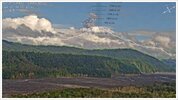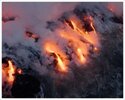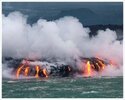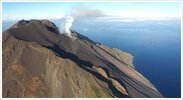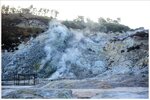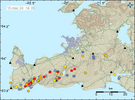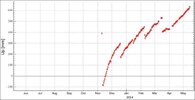XPan
The Living Force
Ruang, Indonesia
3 May 2024

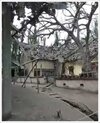
Further volcanic eruptions threaten at Ruang volcano - evacuation measures extended
The island volcano Ruang erupted twice in the second half of April, producing towering ash clouds and pyroclastic flows. The two settlements on Ruang were severely affected. The damage was particularly extensive in the village of Laingpatehi, which was hit by the hot gases of a pyroclastic flow, causing fires. In addition, ash deposits and the bombardment with pyroclastics caused roofs to collapse.
The settlements were evacuated shortly before the eruptions and apparently no one has been injured so far. As a result of the second eruption on 30 April, the exclusion zone around the crater was increased to 7 kilometres, which is why residents of the south-west coast of the neighbouring island of Tagulandang now also live in the danger zone and have to be evacuated. They are particularly threatened by pyroclastic flows, which can also travel long distances across the sea. There are also fears of tsunamis that could occur as a result of landslides.
9,083 people live in the Tagulandang exclusion zone.
By Thursday, 3,364 residents had already been evacuated. The authorities are working to gradually evacuate the remaining 5,719 residents. "At least 9,000 residents within a seven-kilometre radius must be evacuated as soon as possible," said Suharyanto, head of the National Disaster Mitigation Agency (BNPB), in a written statement yesterday. The evacuation is being carried out with the help of several ships.
The government has prepared emergency shelters for affected residents at various locations, such as the Tumou Tou Manado Centre. In fact, people will also be evacuated to the island of Siau, where the Karangetang volcano is located.
Hendra Gunawan, head of PVMBG, explained that in the past, Ruang was prone to emitting pyroclastic flows. According to records, there have been 18 eruption phases of the Ruang volcano since the 19th century, with a clustering of activity in certain periods. Hendra explained that the eruption in 1871 also triggered a tsunami wave and claimed up to 400 lives.
Therefore, the government plans to take permanent measures to relocate residential areas to safer locations, especially Ruang Island. Suharyanto also said that the BNPB would help with the relocation process. This matter is expected to be discussed at ministerial level soon. The forced relocations primarily affect 301 families from two villages at the foot of Mount Ruang.
The two eruptions can be regarded as paroxysms
and we know from other volcanoes that these eruptions often occur in phases, so that further eruptions can be expected in the coming weeks and months. The interval between the two eruptions was 13 days.
Ash is currently being emitted from the crater. Volcanic ash is rising to a height of 1500 metres. Yesterday, 11 volcanotectonic tremors were recorded. Typical for the previous eruptions was the onset of a seismic crisis a few hours before the eruptions.
The alert status is set to "red".
END OF ARTICLE
3 May 2024

Ruang: Weitere Evakuierungen veranlasst - Vulkane Net Newsblog
Am Vulkan Ruang drohen weitere paroxysmale Vulkanausbrüche und die Evakuierungsmaßnahmen wurden deutlich ausgedehnt.
www.vulkane.net

Further volcanic eruptions threaten at Ruang volcano - evacuation measures extended
The island volcano Ruang erupted twice in the second half of April, producing towering ash clouds and pyroclastic flows. The two settlements on Ruang were severely affected. The damage was particularly extensive in the village of Laingpatehi, which was hit by the hot gases of a pyroclastic flow, causing fires. In addition, ash deposits and the bombardment with pyroclastics caused roofs to collapse.
The settlements were evacuated shortly before the eruptions and apparently no one has been injured so far. As a result of the second eruption on 30 April, the exclusion zone around the crater was increased to 7 kilometres, which is why residents of the south-west coast of the neighbouring island of Tagulandang now also live in the danger zone and have to be evacuated. They are particularly threatened by pyroclastic flows, which can also travel long distances across the sea. There are also fears of tsunamis that could occur as a result of landslides.
9,083 people live in the Tagulandang exclusion zone.
By Thursday, 3,364 residents had already been evacuated. The authorities are working to gradually evacuate the remaining 5,719 residents. "At least 9,000 residents within a seven-kilometre radius must be evacuated as soon as possible," said Suharyanto, head of the National Disaster Mitigation Agency (BNPB), in a written statement yesterday. The evacuation is being carried out with the help of several ships.
The government has prepared emergency shelters for affected residents at various locations, such as the Tumou Tou Manado Centre. In fact, people will also be evacuated to the island of Siau, where the Karangetang volcano is located.
Hendra Gunawan, head of PVMBG, explained that in the past, Ruang was prone to emitting pyroclastic flows. According to records, there have been 18 eruption phases of the Ruang volcano since the 19th century, with a clustering of activity in certain periods. Hendra explained that the eruption in 1871 also triggered a tsunami wave and claimed up to 400 lives.
Therefore, the government plans to take permanent measures to relocate residential areas to safer locations, especially Ruang Island. Suharyanto also said that the BNPB would help with the relocation process. This matter is expected to be discussed at ministerial level soon. The forced relocations primarily affect 301 families from two villages at the foot of Mount Ruang.
The two eruptions can be regarded as paroxysms
and we know from other volcanoes that these eruptions often occur in phases, so that further eruptions can be expected in the coming weeks and months. The interval between the two eruptions was 13 days.
Ash is currently being emitted from the crater. Volcanic ash is rising to a height of 1500 metres. Yesterday, 11 volcanotectonic tremors were recorded. Typical for the previous eruptions was the onset of a seismic crisis a few hours before the eruptions.
The alert status is set to "red".
END OF ARTICLE




